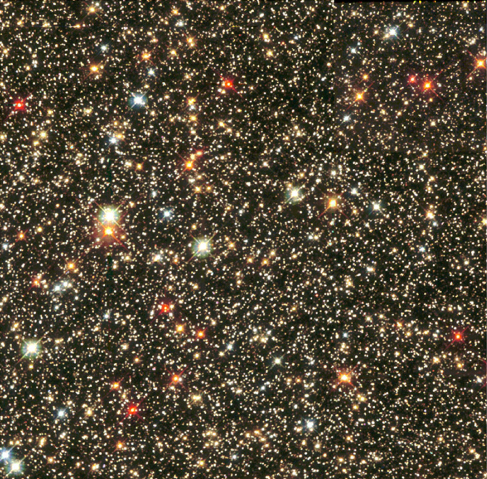What is the order of star colors from coolest to hottest?
Chapter 17 Analyzing Starlight
17.ii Colors of Stars
Learning Objectives
Past the end of this section, you lot will be able to:
- Compare the relative temperatures of stars based on their colors
- Sympathize how astronomers employ colour indexes to measure the temperatures of stars
Look at the beautiful motion picture of the stars in the Sagittarius Star Cloud shown in Figure 17.three. The stars show a multitude of colors, including carmine, orange, yellow, white, and blue. Equally we have seen, stars are not still color considering they do not all accept identical temperatures. To define color precisely, astronomers accept devised quantitative methods for characterizing the color of a star and so using those colors to make up one's mind stellar temperatures. In the chapters that follow, we will provide the temperature of the stars we are describing, and this department tells you lot how those temperatures are determined from the colors of light the stars give off.
Sagittarius Star Cloud.

Color and Temperature
Every bit we learned in The Electromagnetic Spectrum section, Wien'southward police force relates stellar color to stellar temperature. Blue colors dominate the visible low-cal output of very hot stars (with much additional radiation in the ultraviolet). On the other mitt, cool stars emit most of their visible calorie-free free energy at blood-red wavelengths (with more than radiation coming off in the infrared) (Table 17.1). The colour of a star therefore provides a measure of its intrinsic or true surface temperature (apart from the effects of reddening past interstellar dust, which will exist discussed in Between the Stars: Gas and Dust in Space). Color does not depend on the distance to the object. This should be familiar to you from everyday experience. The color of a traffic signal, for example, appears the same no thing how far away it is. If we could somehow have a star, discover it, and so move it much farther abroad, its apparent brightness (magnitude) would alter. But this change in effulgence is the same for all wavelengths, and so its color would remain the same.
| Instance Star Colors and Corresponding Guess Temperatures | ||
|---|---|---|
| Star Colour | Approximate Temperature | Case |
| Bluish | 25,000 Grand | Spica |
| White | 10,000 K | Vega |
| Yellow | 6000 K | Sun |
| Orange | 4000 K | Aldebaran |
| Cherry | 3000 K | Betelgeuse |
The hottest stars take temperatures of over 40,000 K, and the coolest stars have temperatures of virtually 2000 1000. Our Sun's surface temperature is about 6000 Chiliad; its superlative wavelength color is a slightly greenish-yellow. In space, the Sunday would look white, shining with near equal amounts of reddish and blue wavelengths of light. It looks somewhat yellow equally seen from World's surface considering our planet's nitrogen molecules besprinkle some of the shorter (i.e., bluish) wavelengths out of the beams of sunlight that accomplish us, leaving more long wavelength lite behind. This likewise explains why the sky is blue: the blue sky is sunlight scattered past Earth'southward atmosphere.
Canadians in InfiniteJulie Payette was born in Montreal, Quebec. She obtained her Bachelor of Electrical Engineering science cum laude from McGill University and a Principal's of Computer Engineering science from the University of Toronto. After conducting research in computer systems, natural language processing and automatic speech recognition, Julie was selected as ane of iv new Canadian astronauts in 1992.

In 1999, Ms. Payette flew as Mission Specialist during mission STS-96. She became the first Canadian to both participate in an International Space Station associates mission and to board the Space Station itself. Her 2nd spaceflight was during mission STS-127 in 2009, some other assembly mission that lasted xvi days. Robotics applied science was used near every twenty-four hours and Julie operated iii different robotic arms; the Shuttle'due south Canadarm, the Station'south Canadarm2, and a special-purpose appendage on the Kibo Japanese Experiment Module.
Following her space adventures, Julie served stints equally master astronaut for the Canadian Infinite Agency, chief operating part for the Montreal Science Centre, a manager of the National Bank of Canada. In 2017, she was appointed as the 29th Governor General of Canada.
Color Indices
In order to specify the exact colour of a star, astronomers normally measure a star'due south apparent brightness through filters, each of which transmits merely the light from a particular narrow ring of wavelengths (colors). A crude example of a filter in everyday life is a dark-green-colored, plastic, soft drink bottle, which, when held in front of your eyes, lets only the green colors of light through.
One ordinarily used set of filters in astronomy measures stellar brightness at three wavelengths corresponding to ultraviolet, blue, and yellowish light. The filters are named: U (ultraviolet), B (blue), and V (visual, for yellow). These filters transmit low-cal about the wavelengths of 360 nanometers (nm), 420 nm, and 540 nm, respectively. The brightness measured through each filter is usually expressed in magnitudes. The difference between any 2 of these magnitudes—say, between the bluish and the visual magnitudes (B–V)—is chosen a colour index.
Get to this light and filters simulator for a demonstration of how different calorie-free sources and filters can combine to determine the observed spectrum. You can also see how the perceived colors are associated with the spectrum.
By agreement among astronomers, the ultraviolet, blue, and visual magnitudes of the UBV system are adjusted to give a color alphabetize of 0 to a star with a surface temperature of about ten,000 Yard, such as Vega. The B–V color indexes of stars range from −0.4 for the bluest stars, with temperatures of about forty,000 Thou, to +2.0 for the reddest stars, with temperatures of about 2000 K. The B–Five index for the Lord's day is nearly +0.65. Note that, by convention, the B–V index is always the "bluer" minus the "redder" color.
Why employ a color index if it ultimately implies temperature? Considering the brightness of a star through a filter is what astronomers actually measure, and we are always more comfy when our statements have to practice with measurable quantities.
Key Concepts and Summary
Stars have different colors, which are indicators of temperature. The hottest stars tend to announced blue or bluish-white, whereas the coolest stars are ruddy. A colour index of a star is the difference in the magnitudes measured at any two wavelengths and is one mode that astronomers measure out and express the temperature of stars.
Glossary
- color alphabetize
- deviation between the magnitudes of a star or other object measured in light of two different spectral regions—for example, blue minus visual (B–V) magnitudes
Source: https://pressbooks.online.ucf.edu/astronomybc/chapter/17-2-colors-of-stars/
0 Response to "What is the order of star colors from coolest to hottest?"
Post a Comment